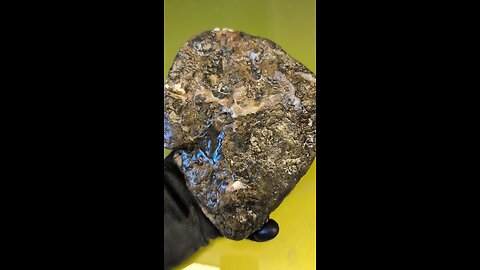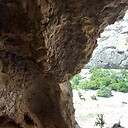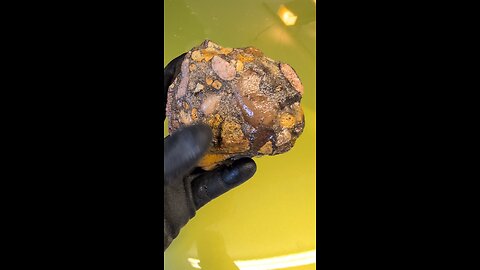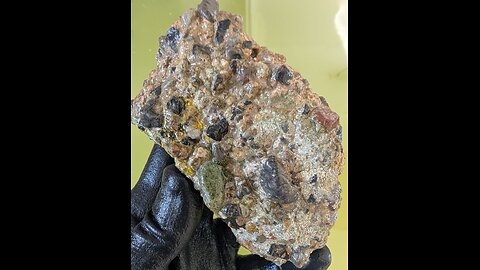
-
Hot mess of Conglomerate!
 HumbleConservativeConglomerate is a type of sedimentary rock characterized by its composition of rounded to subangular gravel-size clasts or larger particles that are cemented together by a finer-grained matrix. Here are some key points about conglomerate: Composition: Conglomerates are made up of various rock fragments, pebbles, and sometimes even larger stones, all of which are embedded in a matrix of sand, silt, or clay. The clasts can be of different rock types, including quartz, granite, basalt, or limestone. Formation: They form in environments where there is strong water current or wave action, such as riverbeds, beaches, or alluvial fans, which can transport and deposit these larger particles. Over time, these deposits are compacted and cemented by minerals like silica, calcium carbonate, or iron oxide. Texture: The texture of conglomerate is quite distinctive due to the presence of larger, rounded clasts within a finer matrix. This gives it a "cobblestone" or "pudding stone" appearance. Color: The color of conglomerate can vary widely depending on the composition of the clasts and the cementing material. It can range from light to dark colors, often reflecting the colors of the included fragments. Uses: Conglomerate is sometimes used as a building stone due to its durability, though it's less common than other rocks like sandstone or limestone. It's also of interest in geology for understanding ancient environments and sediment transport processes.41 views
HumbleConservativeConglomerate is a type of sedimentary rock characterized by its composition of rounded to subangular gravel-size clasts or larger particles that are cemented together by a finer-grained matrix. Here are some key points about conglomerate: Composition: Conglomerates are made up of various rock fragments, pebbles, and sometimes even larger stones, all of which are embedded in a matrix of sand, silt, or clay. The clasts can be of different rock types, including quartz, granite, basalt, or limestone. Formation: They form in environments where there is strong water current or wave action, such as riverbeds, beaches, or alluvial fans, which can transport and deposit these larger particles. Over time, these deposits are compacted and cemented by minerals like silica, calcium carbonate, or iron oxide. Texture: The texture of conglomerate is quite distinctive due to the presence of larger, rounded clasts within a finer matrix. This gives it a "cobblestone" or "pudding stone" appearance. Color: The color of conglomerate can vary widely depending on the composition of the clasts and the cementing material. It can range from light to dark colors, often reflecting the colors of the included fragments. Uses: Conglomerate is sometimes used as a building stone due to its durability, though it's less common than other rocks like sandstone or limestone. It's also of interest in geology for understanding ancient environments and sediment transport processes.41 views -
Fruity Pebbles Conglomerate!
 HumbleConservativeConglomerate is a type of sedimentary rock characterized by its composition of rounded to subangular gravel-size clasts or larger particles that are cemented together by a finer-grained matrix. Here are some key points about conglomerate: Composition: Conglomerates are made up of various rock fragments, pebbles, and sometimes even larger stones, all of which are embedded in a matrix of sand, silt, or clay. The clasts can be of different rock types, including quartz, granite, basalt, or limestone. Formation: They form in environments where there is strong water current or wave action, such as riverbeds, beaches, or alluvial fans, which can transport and deposit these larger particles. Over time, these deposits are compacted and cemented by minerals like silica, calcium carbonate, or iron oxide. Texture: The texture of conglomerate is quite distinctive due to the presence of larger, rounded clasts within a finer matrix. This gives it a "cobblestone" or "pudding stone" appearance. Color: The color of conglomerate can vary widely depending on the composition of the clasts and the cementing material. It can range from light to dark colors, often reflecting the colors of the included fragments. Uses: Conglomerate is sometimes used as a building stone due to its durability, though it's less common than other rocks like sandstone or limestone. It's also of interest in geology for understanding ancient environments and sediment transport processes.65 views
HumbleConservativeConglomerate is a type of sedimentary rock characterized by its composition of rounded to subangular gravel-size clasts or larger particles that are cemented together by a finer-grained matrix. Here are some key points about conglomerate: Composition: Conglomerates are made up of various rock fragments, pebbles, and sometimes even larger stones, all of which are embedded in a matrix of sand, silt, or clay. The clasts can be of different rock types, including quartz, granite, basalt, or limestone. Formation: They form in environments where there is strong water current or wave action, such as riverbeds, beaches, or alluvial fans, which can transport and deposit these larger particles. Over time, these deposits are compacted and cemented by minerals like silica, calcium carbonate, or iron oxide. Texture: The texture of conglomerate is quite distinctive due to the presence of larger, rounded clasts within a finer matrix. This gives it a "cobblestone" or "pudding stone" appearance. Color: The color of conglomerate can vary widely depending on the composition of the clasts and the cementing material. It can range from light to dark colors, often reflecting the colors of the included fragments. Uses: Conglomerate is sometimes used as a building stone due to its durability, though it's less common than other rocks like sandstone or limestone. It's also of interest in geology for understanding ancient environments and sediment transport processes.65 views -
Conglomerate!
 HumbleConservativeConglomerate is a clastic sedimentary rock composed mainly of rounded gravel-size clasts (pebbles, cobbles, and sometimes boulders) that are cemented together by a matrix of finer-grained sediments like sand, silt, or clay. Here are some key details about conglomerate: Formation: Conglomerate forms in environments where there is strong water current or wave action that can transport and round the larger clasts before they are deposited. Common depositional environments include riverbeds, beaches, alluvial fans, and the bases of山 slopes where debris flows occur. Over time, these deposits are buried, compacted, and cemented. Composition: Clasts: These are the larger, rounded fragments which can be composed of various rock types like quartz, granite, basalt, or even other sedimentary rocks. Matrix: The finer material that fills the spaces between the clasts, often composed of sand, silt, or clay. Cement: Minerals like silica, calcium carbonate, or iron oxides that bind the clasts and matrix together. Texture: Conglomerate has a coarse texture due to the presence of larger clasts. The texture can be described as poorly sorted if there is a wide range of clast sizes, or well-sorted if the clasts are more uniform in size. Color: The color of conglomerate varies based on the composition of both the clasts and the matrix. Clasts can be of different colors depending on the source rock, and the matrix color can range from light to dark, influenced by the cementing material. Types: Orthoconglomerate: Where the clasts are well-rounded and the matrix is minimal or absent. Paraconglomerate: Where the clasts are less rounded and there's a significant matrix, indicating less transport or different depositional conditions. Uses: Construction: Due to its durability, conglomerate can be used in construction for building stone, road base, or as an aggregate in concrete. Decorative: Its unique appearance with varied clasts makes it suitable for decorative stone in landscaping or interior design. Geological Studies: It provides valuable information about past environments, particularly regarding sediment transport and deposition. Geological Significance: Conglomerate layers can tell geologists about the energy of the environment where they were deposited, the source of the clasts, and the processes involved in their formation. They can indicate ancient river systems, coastal environments, or even glacial activity.16 views
HumbleConservativeConglomerate is a clastic sedimentary rock composed mainly of rounded gravel-size clasts (pebbles, cobbles, and sometimes boulders) that are cemented together by a matrix of finer-grained sediments like sand, silt, or clay. Here are some key details about conglomerate: Formation: Conglomerate forms in environments where there is strong water current or wave action that can transport and round the larger clasts before they are deposited. Common depositional environments include riverbeds, beaches, alluvial fans, and the bases of山 slopes where debris flows occur. Over time, these deposits are buried, compacted, and cemented. Composition: Clasts: These are the larger, rounded fragments which can be composed of various rock types like quartz, granite, basalt, or even other sedimentary rocks. Matrix: The finer material that fills the spaces between the clasts, often composed of sand, silt, or clay. Cement: Minerals like silica, calcium carbonate, or iron oxides that bind the clasts and matrix together. Texture: Conglomerate has a coarse texture due to the presence of larger clasts. The texture can be described as poorly sorted if there is a wide range of clast sizes, or well-sorted if the clasts are more uniform in size. Color: The color of conglomerate varies based on the composition of both the clasts and the matrix. Clasts can be of different colors depending on the source rock, and the matrix color can range from light to dark, influenced by the cementing material. Types: Orthoconglomerate: Where the clasts are well-rounded and the matrix is minimal or absent. Paraconglomerate: Where the clasts are less rounded and there's a significant matrix, indicating less transport or different depositional conditions. Uses: Construction: Due to its durability, conglomerate can be used in construction for building stone, road base, or as an aggregate in concrete. Decorative: Its unique appearance with varied clasts makes it suitable for decorative stone in landscaping or interior design. Geological Studies: It provides valuable information about past environments, particularly regarding sediment transport and deposition. Geological Significance: Conglomerate layers can tell geologists about the energy of the environment where they were deposited, the source of the clasts, and the processes involved in their formation. They can indicate ancient river systems, coastal environments, or even glacial activity.16 views

